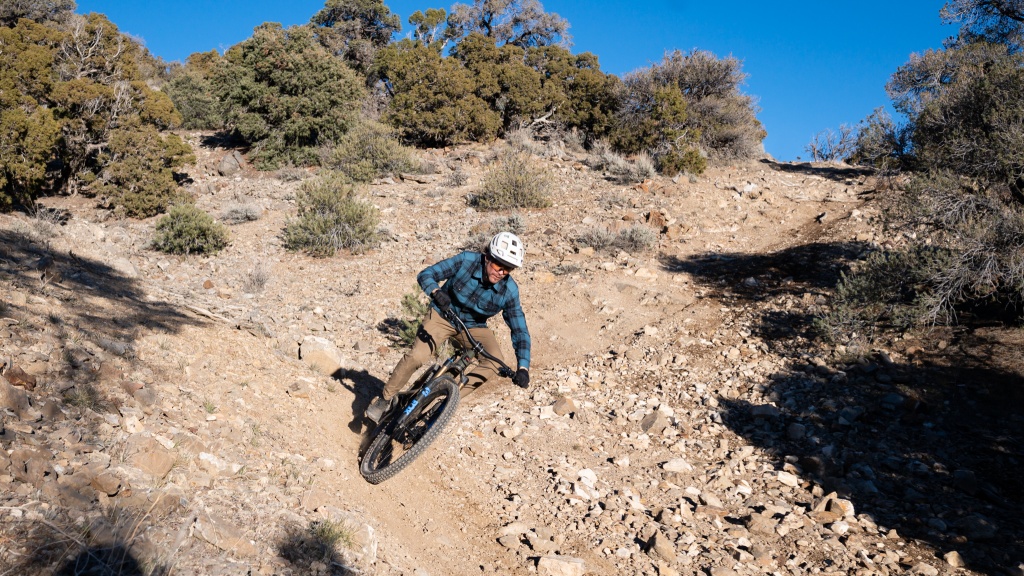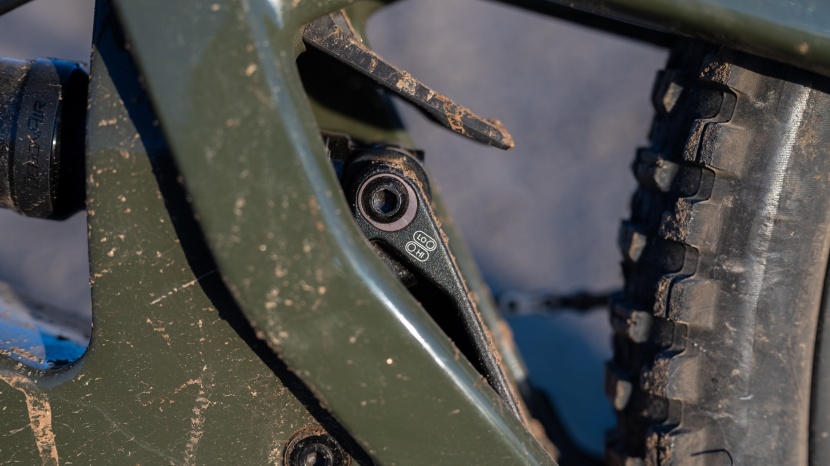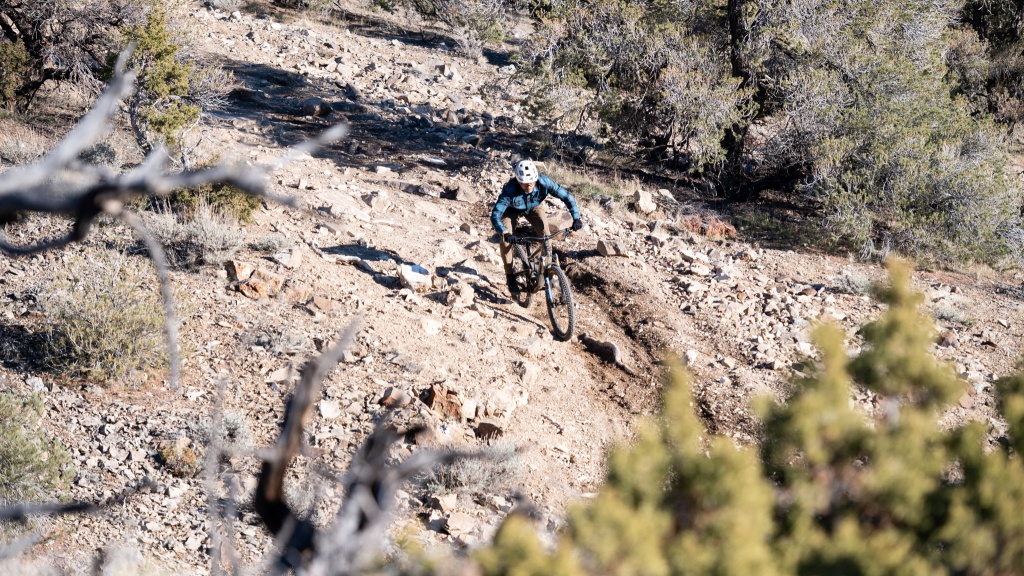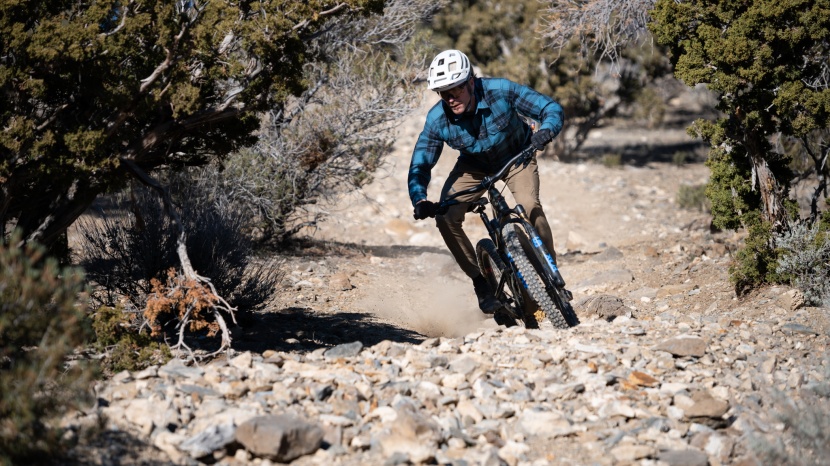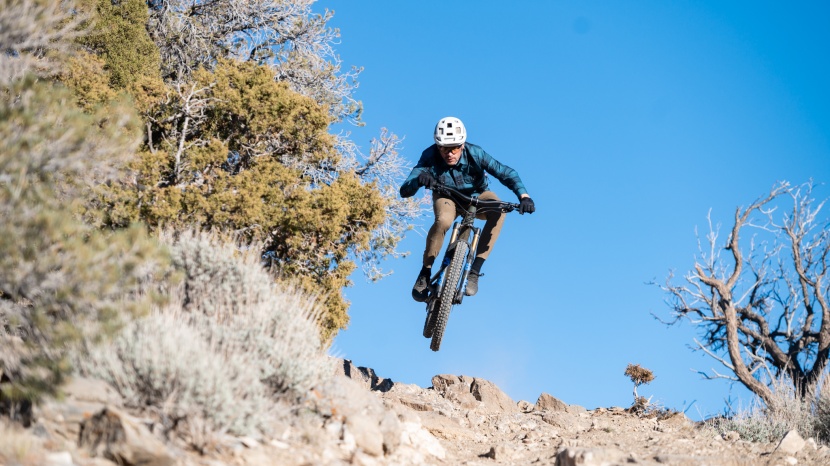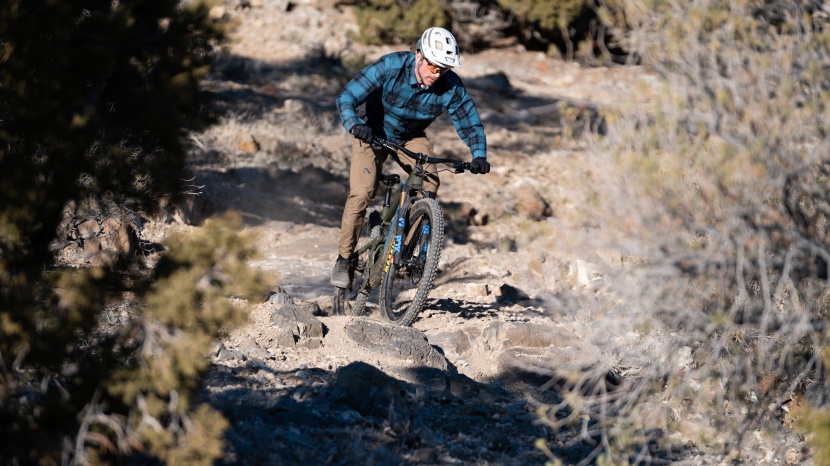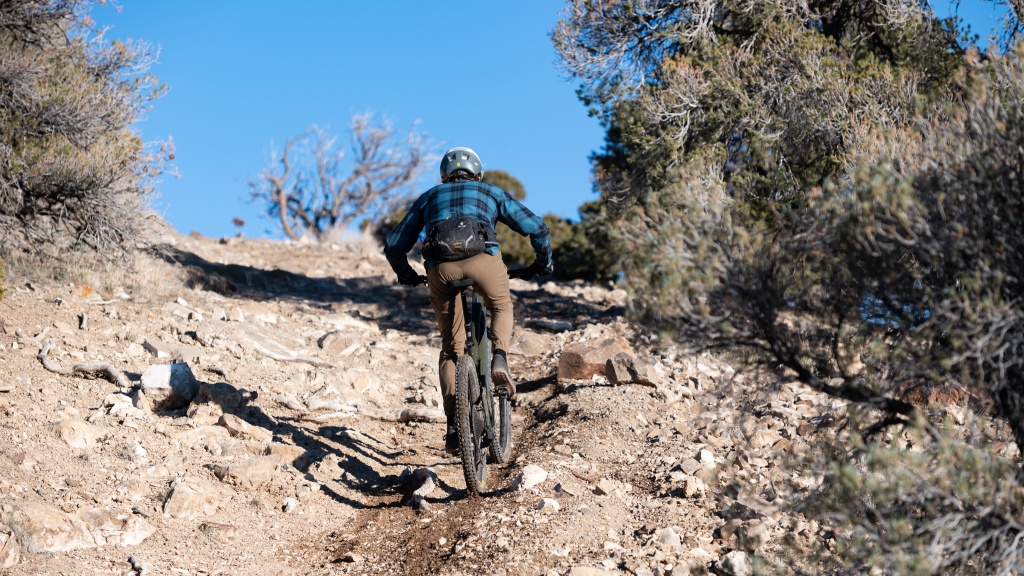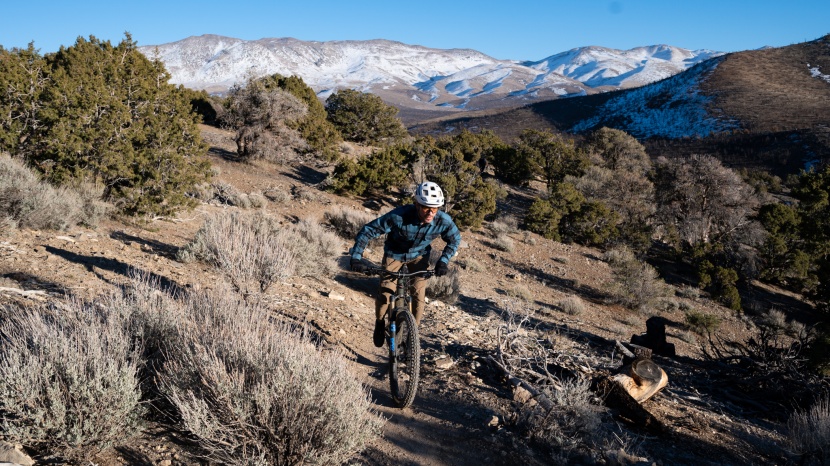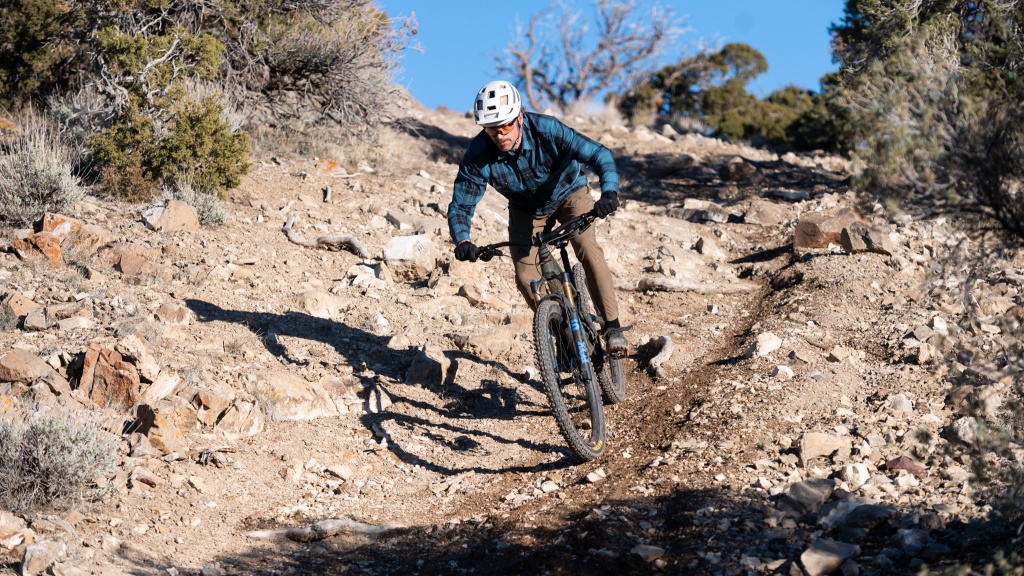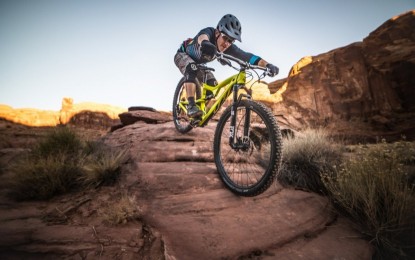Santa Cruz Bronson XO1 AXS RSV Review
Our Verdict
Compare to Similar Products
 This Product
Santa Cruz Bronson XO1 AXS RSV | |||||
|---|---|---|---|---|---|
| Awards | Best Aggressive Trail Bike | Best Overall Trail Bike | |||
| Price | $10,549 List | $7,299 List | $5,999 List | $5,500 List | $2,999 List |
Overall Score  |
|||||
| Star Rating | |||||
| Bottom Line | Business in front, party in the back, mixed wheels=maximum fun for this aggressive trail bike | The best gets even better, and the V2 Ripmo is the best all-around trail bike we've ever tested | Trek delivers everything we want in a modern trail bike with a highly adjustable frame and a confidence-inspiring ride | Two models turned into one is a win for manufacturing efficiency; it's an excellent bike, but so are the two it replaces | The aluminum framed Ibis Ripmo AF is the best aggressive trail bike you'll find at this price |
| Rating Categories | Santa Cruz Bronson... | Ibis Ripmo V2 XT | Trek Fuel EX 9.8 GX... | Specialized Stumpju... | Ibis Ripmo AF NX Eagle |
| Fun Factor (25%) | |||||
| Downhill Performance (35%) | |||||
| Climbing Performance (35%) | |||||
| Ease of Maintenance (5%) | |||||
| Specifications | Santa Cruz Bronson... | Ibis Ripmo V2 XT | Trek Fuel EX 9.8 GX... | Specialized Stumpju... | Ibis Ripmo AF NX Eagle |
| Wheel size | MX (29" front, 27.5" rear) | 29" | 29" | 29" or MX | 29" |
| Suspension & Travel | Virtual Pivot Point (VPP - 150mm) | DW-Link - 147mm | ABP - 140mm | FSR - 145mm | DW-Link - 147mm |
| Measured Weight (w/o pedals) | 30 lbs 7 oz (Large) | 31 lbs (Large) | 32 lbs 9 oz (Large) | 32 lbs 9 oz (S4) | 34 lbs (Large) |
| Fork | Fox 36 Float Factory - 160mm | Fox Float 36 Grip 2 Factory 160mm | Fox 36 Performance 150mm | Fox 36 Float Rythym 150mm | DVO Diamond D1 160mm |
| Shock | RockShox Super Deluxe Ultimate | Fox Float X2 | Fox Performace Float X | FOX FLOAT Performance with Specialized GENIE | DVO Topaz T3 Air |
| Frame Material | Carbon Fiber "CC" | Carbon Fiber | Carbon Fiber OCLV | Carbon Fiber | Aluminum |
| Frame Size | Large | Large | Large | S4 (Large equivalent) | Large |
| Frame Settings | Flip Chip | N/A | Mino Link, Adjustable leverage | Headtube Nagle | N/A |
| Available Sizes | XS-XL | S-XL | XS-XL | S1-S6 | S-XL |
| Wheelset | Reserve 30 V2 Carbon with Industry Nine 1/1 hubs | Ibis S35 Aluminum rims with Ibis hubs, 35mm ID | Bontrager Line Elite 30, 30mm ID | Specialized 30mm, Alloy hubs | Ibis S35 Aluminum rims with Ibis hubs, 35mm ID |
| Front Tire | Maxis Minion DHF 2.5" EXO 3C Maxx-Grip | Maxxis Assegai EXO+ 2.5" | Bontrager SE5 Team Issue 2.5" | Specialized Butcher GRID TRAIL T9, 2.3" | Maxxis Assegai EXO+ 2.5" |
| Rear Tire | Maxxis Minion DHR II 2.4" EXO 3C | Maxxis Assegai EXO+ 2.5" | Bontrager SE5 Team Issue 2.5" | Specialized Eliminator GRID TRAIL T7, 2.3" | Maxxis Assegai EXO+ 2.5" |
| Shifters | SRAM GX AXS | Shimano XT 12-speed | SRAM GX Eagle AXS | SRAM AXS Pod | SRAM NX Eagle |
| Rear Derailleur | SRAM XO1 Eagle AXS | Shimano XT M8100 Shadow | Sram GX Eagle AXS | SRAM S1000 | SRAM NX Eagle |
| Crankset | SRAM X1 Carbon 32T | Shimano XT M8100 170mm 32T | SRAM GX Eagle DUB 170mm 32T | SRAM S1000 170mm 32T | SRAM NX Eagle DUB 32T |
| Saddle | WTB Volt Medium | WTB Silverado Pro 142mm | Bontrager Arvada 138mm | Specialized Bridge Comp | WTB Silverado Pro |
| Seatpost | RockShox Reverb Stealth | Bike Yoke Revive (185mm size large) | Bontrager Line Elite 170mm | X-Fusion Manic 190mm (S4/S6), 34.9 diameter | KS Rage-i 150mm(Large) |
| Handlebar | Santa Cruz 35 Carbon 780mm 35mm rise | Ibis Adjustable Carbon 800mm (30mm rise) | Bontrager Carbon RSL Integrated 820mm | Specialized 6061 alloy, 30mm rise, 800mm width | Ibis 780mm Alloy |
| Stem | Burgtec Enduro MK3 | Thomson Elite X4 | Bontrager RSL Integrated 45mm | Specialized Alloy Trail stem, 35mm bore | Ibis 31.8 50mm |
| Brakes | SRAM Code RSC | Shimano XT M8120 4-piston | SRAM Code R | SRAM Maven Bronze | SRAM Guide T 4 piston |
| Measured Effective Top Tube (mm) | 623 | 632 | 627 | 624 | 631 |
| Measured Reach (mm) | 475 | 475 | 485 | 475 | 473 |
| Measured Head Tube Angle | 64.7-degrees H/64.5-degrees L | 64.9-degrees | 63.5-65.5 (adjustable) | 63.5-65-degree (adjustable) | 64.9-degrees |
| Measured Seat Tube Angle | 76.9-degrees H/76.5-degrees L | 76-degrees | 77.3-degrees H/76.8-degrees L | 76.5-degrees | 76-degrees |
| Measured Bottom Bracket Height (mm) | 344 H/341 L | 341 | 342 H/338 L | 337 H / 330 L | 340 |
| Measured Wheelbase (mm) | 1249 | 1238 | 1250 | 1244 | 1239 |
| Measured Chain Stay Length (mm) | 438 (varies by size) | 435 | 440 (varies by size) | 435 (S3-S4) | 435 |
| Warranty | Lifetime | Seven Years | Lifetime | Lifetime | Seven Years |
Our Analysis and Test Results
Since we last tested the Bronson, Santa Cruz has updated the frame with some geometry and kinematic tweaks. We're working on a review of an updated bike that has a different appearance in the bottom bracket area; this is due to getting the shock mounted even lower. Does it make a significant difference in ride quality? Check back soon for our review and answers.
Tested and Rated
Mountain bike reviews are often paid endorsements from organizations that accept free bikes in return for publishing a glowing review. At GearLab, we don't operate that way. We purchase all of the bikes we test or, in rare cases, rent them as demos, leaving us free to give you our honest opinions and unfettered feedback. What I loved about this Bronson is how rowdy it felt; this bike inspired me to let it all hang out and push my limits. While it's adept pretty much everywhere, the bike seems to relish its time in the air.
Should I Buy This Bike?
Mullet hairstyles may not be quite as common as they once were, but mullet bikes have steadily been gaining popularity for the past few years. When it came time to update the Bronson, Santa Cruz made the somewhat bold move to mixed wheel sizes. It may not be a Hemi, but we think Joe Dirt might still say “Daaannngg” when he saw it. The switch to mixed wheels (MX) along with an updated geometry have made the new Bronson more confident in aggressive terrain while retaining the versatility and maneuverability of its predecessor. With 150mm of rear-wheel travel paired with a 160mm fork, it fits squarely in the aggressive trail travel bracket, and the added length, slacker head angle, and mullet wheels have done wonders to enhance its downhill prowess. We found the Bronson to get better the harder you push it, with great stability at speed and composure in steep and rough terrain. The 29-inch front wheel provides a business-minded approach, while the 27.5-inch rear wheel keeps things lively and fun. Steep, skiddy trails and slashy corners were where we felt the Bronson excelled, but it proved to be tons of fun on moderate, flowy terrain as well. While it may not be most supple, the VPP suspension design performs better than most on bigger hits and provides a supportive platform to push off when popping side hits or blasting out of corners. Like most Santa Cruz bikes, it has a very calm pedaling platform that renders the climb switch nearly useless, and it proved to be an efficient climber capable of tackling anything we put in front of it. It isn't necessarily the fastest bike up or down the mountain, but it does strike us as one of the most fun we've tested in a while.
The Stumpjumper Evo is a similar bike in that it's an aggressive trail bike that sports 150mm of rear travel paired with a 160mm fork. The Stumpy is designed around matched 29-inch wheels, although Specialized makes a “mullet link,” so you can switch to a mixed wheel setup if you like, although you'll need to buy the link and a new rear wheel. In its stock configuration, the Stumpjumper is perhaps a touch faster all around than the Bronson, but it can't quite match its snappy feel. The Stumpjumper is far more adjustable, so you can better match the geometry to your riding style or terrain, while the Bronson sits in the sweet spot for most riders with a very small range of adjustability. Both bikes are very versatile and can stand up to some seriously aggressive riding, but to us, the Bronson seems like a bit more of a niche bike aimed at the rider looking for a purpose-built mixed-wheel fun-hog of a bike. The Stumpy EVO takes a more business-like approach with a very high level of versatility achieved through its adjustability.
Compared to a couple of other Santa Cruz bikes we've tested, the 5010 and the Hightower, the Bronson has a personality all its own. The 5010 has 130mm of rear-wheel travel, rolls on matched 27.5-inch wheels, and is one of the most playful and fun bikes we've tested. On the other hand, the Hightower is more of a purebred trail bike with matched 29-inch wheels and 145mm of rear-wheel travel. The Bronson feels a bit like a cross between the two, just with a touch more travel and slightly more aggressive geometry. It has the confidence and stability of a 29er with the snappiness and maneuverability of a 27.5er. You might even call it the best of both worlds.
Frame Design
The Bronson has been a mainstay in Santa Cruz's lineup for nearly a decade, and it got a major overhaul for the 2022 model year. It shares many similarities with the previous version but is now purpose-built for the mixed wheel (MX), or mullet, configuration with a 27.5" rear wheel and a 29" in the front. S-XL frame sizes come with the MX setup, while XS frames come with 27.5" wheels front and rear. Our XO1 AXS RSV test bike is built around the high-end Carbon CC frame with 150mm VPP (Virtual Pivot Point) rear suspension and the now ubiquitous low shock mount orientation. The Bronson is also offered in the slightly heavier but less expensive Carbon C frame. Currently, there are no aluminum frame options. The frame has clean lines like the rest of Santa Cruz's line and features sleeved internal cable routing, integrated downtube, shuttle, chainstay protection, and plenty of room within the front triangle for a full-size water bottle. Santa Cruz's sister brand, Juliana, also makes the Roubion, which is essentially the same bike with different color options and touchpoints.
The Bronson has 150mm of low-mount VPP rear suspension paired with a 160mm fork. This VPP platform is the same as found on virtually all of Santa Cruz's trail and enduro bikes, with the shock mounted low on the downtube, passing through a hole near the bottom of the seat tube, and attaching to the lower link. The lower link connects the front triangle and the rigid rear triangle just behind the bottom bracket, and the upper link is attached to the top tube just in front of the seat tube and to the top of the seat stays. Flip-chips in the lower shock mount allow you to make minor adjustments to the Bronson's geometry. The Bronson is only offered with an air shock, but it is also compatible with coil shocks.
Geometry-wise, the new Bronson is a departure from the previous version, but not wildly so. The new geometry falls squarely into the aggressive trail/all-mountain bracket. The chainstay length/rear center is size-specific to maintain a balanced ride across the size spectrum. The rear center starts at 427mm on the size XS and grows to 442mm on the size XL, and our size Large measured 438mm. Low standover heights across all sizes allow the rider to pick a frame size based on their preferred reach, and our Large test bike came in at a comfortable 475mm, along with a long-ish 1,249mm wheelbase. In the high setting, it has a relatively slack 64.7-degree head tube angle and a comfortably steep 76.9-degree seat tube angle. Flipping the chips slackens the head tube angle by 0.2 degrees to 64.5 and axes the seat tube angle by 0.4 degrees to 76.5 degrees. The bb height sits at 344/341mm in the high/low settings, respectively.
Design Highlights
- Carbon C or Carbon CC (tested) frames only
- Mixed wheels, 27.5" rear and 29" front (size XS comes with matched 27.5" wheels)
- Frame designed specifically for the mixed wheel configuration
- 150mm of VPP rear suspension
- Designed around a 160mm fork
- Full sleeve internal cable routing
- Integrated downtube, shuttle, and chainstay protection
- Complete builds range in price from $5,049 to $11,399
- Available as Carbon CC frame only for $3,699
Downhill Performance
The Bronson really comes alive on the descents with a bit of speed or when the trails get steep and rowdy. The move to mixed wheels provides a confident front end for stability and plowing over the rough stuff, while the 27.5-inch rear wheel keeps the bike feeling snappy and easily maneuverable. The updated geometry allows for some seriously aggressive riding yet remains fun on a wide range of terrain, and the 150 rear and 160mm of front travel provide enough squish for most situations. It goes without saying that the high-end build we tested performed marvelously on the descents.
Throwing a leg over the Bronson for the first time, it became apparent to our testers that riding a mixed-wheel setup feels slightly different than a full 29er. While it isn't a major departure from a matched-wheel bike, it does take a few minutes, or maybe a ride or two, to get used to. Considering the fact that Santa Cruz designed the frame specifically for mullet wheels, the majority of the geometry feels relatively normal. We did notice, however, that the front end of the bike felt somewhat high, and we compensated for that by lowering the stem about as far as it would go. Even with the handlebar lower, we did find ourselves needing to consciously weight the front end a little more than usual in corners on more moderate terrain. This was, however, something that we got used to pretty quickly. Interestingly, the Bronson has roughly the same stack height as the Hightower, which didn't give us the same feeling. We assume this is a result of the smaller wheel in the back and the difference in axle-to-ground heights front and rear. The flip side is that the Bronson feels super comfortable when riding down steep trails. The difference in wheel sizes automatically gives you a slight rearward weight bias, and the tall feeling front end feels like it keeps you in the driver's seat, providing confidence and composure for the rider. Not to mention the fact that it's less likely to buzz your butt with the rear tire, and it feels great slashing turns.
Beyond that quirk, the updated geometry is longer and slacker than the previous version, but right around the sweet spot for modern aggressive trail bikes. It's wild to think that just a few years ago the Bronson's geometry would have been quite extreme, but it's almost moderate when compared to some other bikes on the market today. We found the 64.7/64.5-degree head tube angle (high/low settings, respectively) to provide a confident front end that avoids being too slacked out. The 475mm reach on our size large is comfortably roomy without feeling too long. The size-specific chainstays, 438mm on our large, aren't exactly short, but they do provide good stability, particularly when combined with the long-ish 1,249mm wheelbase length. Despite that length, the Bronson remains easily maneuverable, and the smaller rear wheel really comes around in the corners. It rails through berms and performs really well in tight, twisty, and steep trails. We also found it to feel almost eager to get off the ground, and it was notably comfortable and balanced in the air.
Suspension travel remains the same as the previous version, with 150mm in the rear paired with a 160mm fork. We feel this travel length strikes a great balance, with enough to handle virtually any situation but not so much that it feels like you're pedaling a full-blown enduro bike around all the time. The low shock mount VPP suspension design has excellent mid-stroke support and adequate progression to prevent blowing through the travel on bigger hits or drops, and it stays remarkably composed when deep in its travel. We feel it doesn't have the best small bump compliance compared to some other designs, though the frame is compatible with coil shocks for those who wish to make it a little more supple off the top. While somewhat difficult to clean, the low-mount VPP design is sturdy and it makes for a nice, stiff interface between the front and rear triangles. The super beefy downtube and head tube junction add to the bike's burly and stout feel.
As expected, the XO1 AXS RSV build is stellar on the descents. The Fox 36 Factory fork is stiff enough, and the Grip 2 damper offers both high and low compression and rebound adjustments for dialing it just how you like. The RockShox Super Deluxe Ultimate shock performs well at the back of the bike as well. Our test bike rolls on Reserve 30 Carbon rims laced to Industry Nine 1/1 hubs. The beefy wheels have a reasonably low weight and a balanced ride feel, and they come with a lifetime warranty. The Maxxis Minion DHF in the front is paired with a Maxxis Minion DHR II in the back for an aggressive trail riding combo that provides excellent cornering and braking traction. The EXO casing of those tires, however, might be a little under-gunned for some riders out there. Our testers tend to prefer Shimano brakes, but the SRAM Code RSC's provide good stopping power and modulation, and the 200mm front rotor helps you slow down in a hurry. A stout Burgtec Enduro MK3 stem clamps an 800mm wide, 30mm rise Santa Cruz Carbon handlebar for precise steering and control and excellent vibration dampening. A 175mm (size large) RockShox Reverb dropper gets the saddle low and out of the way on descents. Taller riders might balk at that length, as there is plenty of room to go longer, but we found it to be adequate most of the time.
Climbing Performance
Climbing aboard the Bronson is a comfortable and hassle-free affair. The geometry provides a relatively relaxed climbing position, and the VPP suspension platform keeps things feeling efficient, as we've come to expect from Santa Cruz's bikes. While it didn't feel like the fastest bike up the hill, there was nothing we put in front of it that it couldn't handle, within reason, of course.
Seat tube angles are a hot topic in mountain bike geometry these days, trending steeper and steeper. Santa Cruz didn't go too crazy here but gave the Bronson a fairly steep 76.9-degree effective seat tube angle (size large, high setting) that relaxes to 76.5 degrees in the low setting. Additionally, the actual seat tube angle is fairly steep, so riders at the upper limits of a bike's sizing won't end up with their weight too far back over the rear wheel. We found this lined the rider up nicely above the bottom bracket with an up-top position and direct power transfer straight down into the cranks. The 475mm reach is nice and roomy, but the steep seat tube and the tall feeling front end (mentioned above) made for a comfortable position that never felt too stretched out. The 438mm chainstays/rear center length (this length varies by frame size) and 1,249mm wheelbase are fairly long but give the bike a balanced feel, and it remained surprisingly maneuverable through technical sections and tight turns. Despite the bike's overall length and relatively slack front end, we had no issues with steering feeling light or wander-y, even on the steepest climbs. Even with the smaller rear wheel, the bottom bracket height is high enough that pedal strikes weren't really an issue.
We've tested several other Santa Cruz models with the low shock mount VPP suspension design, and we've always been impressed by its climbing efficiency. While there is the tiniest bit of suspension movement, it remains quite calm while pedaling when seated and standing. It feels like there is very little energy wasted while still providing excellent traction on the trail surface. In fact, we left the climbing switch on the RockShox Super Deluxe Ultimate shock in the open position nearly all the time, save for a few paved and dirt road grinds. While it feels efficient, the Bronson never struck us as being particularly fast. Don't get us wrong, it cruises uphill just fine, but it doesn't do so with the sense of urgency that some other bikes have. Of course, this is an aggressive trail bike with a mixed-wheel setup, so that doesn't necessarily come as too much of a surprise. The 29-inch front wheel rolls over obstacles quite effectively, but the 27.5-inch rear wheel is a little more prone to hanging up than a larger wheel would be.
The XO1 AXS RSV build performs exceptionally well on the uphills. Our large test bike tipped the scales at 30 lbs 7 oz, which is reasonably lightweight for a burly and aggressive bike. The XO1 AXS shifting is a thing of beauty with crisp shifts and plenty of range; plus, you can customize the shifter paddle through the app to be exactly how you want it. The Reserve Carbon 30 wheels are fairly lightweight, which helps to reduce rotational weight, and the Industry Nine 1/1 hubs have quick 4-degree engagement that simply feels great. The Maxxis Minion DHR II is a great rear tire that provides excellent pedaling traction in a wide range of conditions. Lastly, the WTB Volt saddle is a long-time tester favorite and a comfortable perch to sit and spin away the vertical.
Photo Tour
Value
There's no denying that the XO1 AXS RSV build of the Bronson we tested is expensive. That said, it's about as dialed of a build as you could hope for, and quite frankly, mountain bikes are expensive and aren't changing anytime soon. Considering what you get for that price, we feel it is competitive with high-end builds from other major manufacturers. Of course, your disposable income and willingness to spend a lot of money on a bike will dictate whether or not this bike is a good value to you. Several other less expensive build options (and one more expensive) are available that will get you out on the new Bronson for thousands less. We think the current XT build hits the sweet spot of price and performance.
Conclusion
Having tested the previous two versions of the Bronson, we feel confident saying that the latest is definitely the greatest. With a move from matched 27.5-inch wheels to a mixed wheel setup along with updated geometry, the Bronson retains its versatility but inspires the confidence to ride much more aggressive terrain. The big wheel up front provides stability and composure, while the smaller rear wheel keeps it feeling sporty and fun. If you've been wanting to channel your inner Joe Dirt and charging descents, slapping corners, and catching air is your idea of a good time, then check out the new Bronson.







